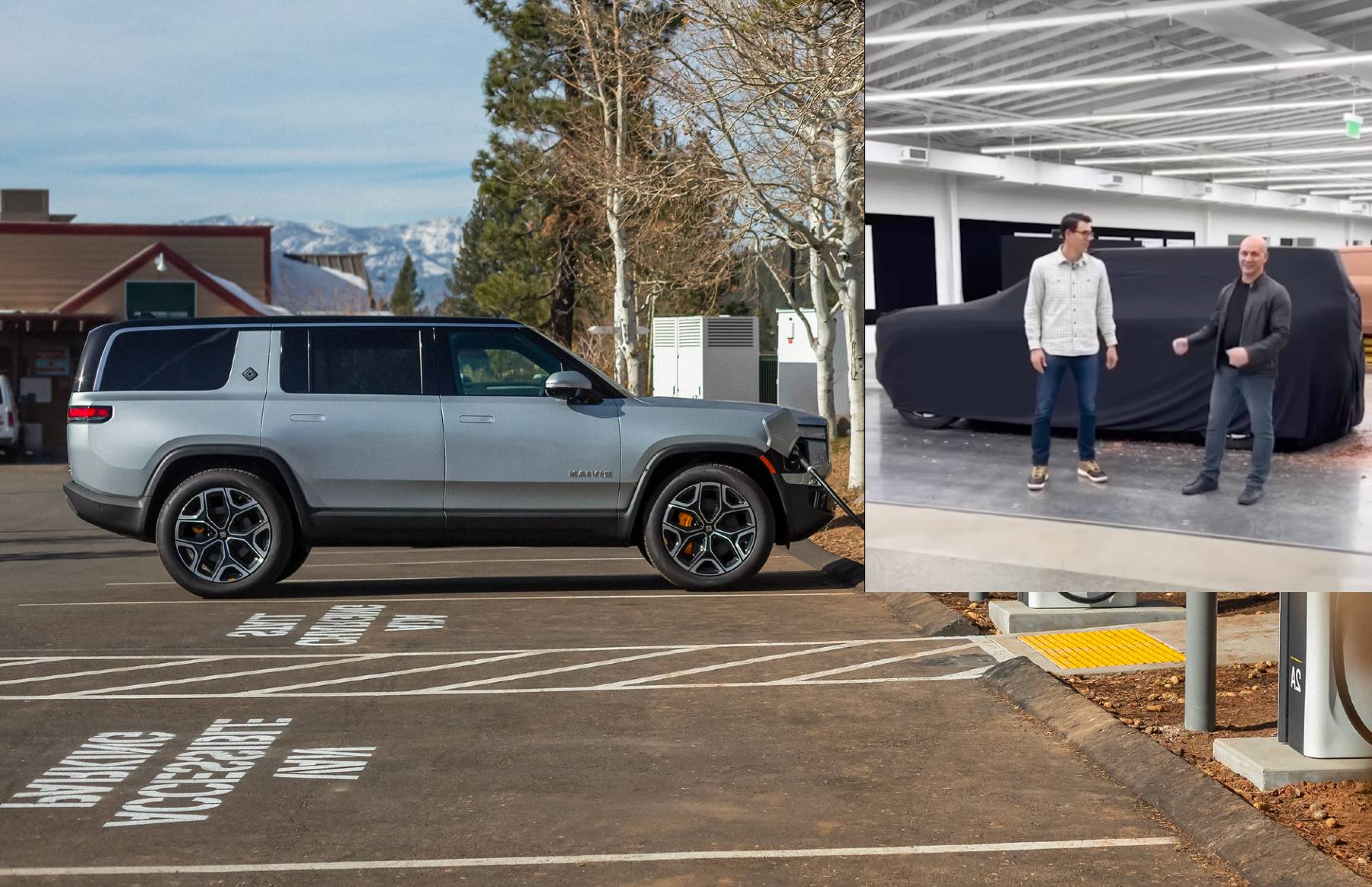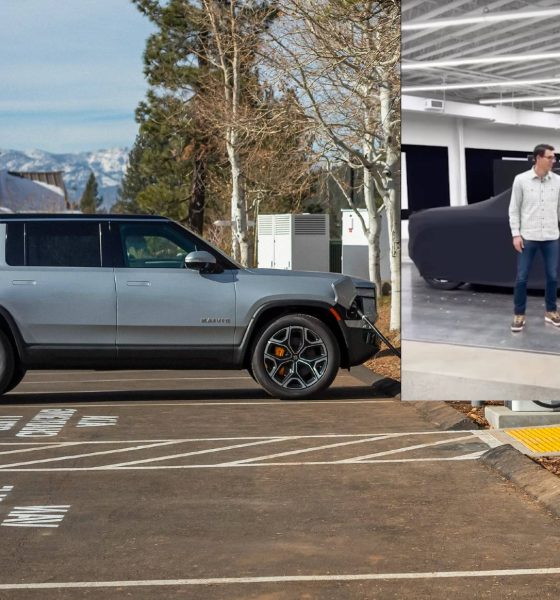

News
Rivian’s R2 SUV is coming just in time for the next wave of new BEVs [Opinion]
Rivian CEO and Founder RJ Scaringe teased details about the Rivian R2 SUV, the smaller sibling of the company’s R1S vehicle. The Rivian R2 is expected to launch by 2024 when a new wave of battery-electric vehicles is expected to arrive.
Scaringe teased the Rivian R2 SUV during his Instagram Q&A session last weekend. The tease was brief but sufficient to reveal that Rivan is indeed developing a new vehicle. The company covered the R2 with a black cloth, so the audience could only see its silhouette.
Based on its brief appearance during Scaringe’s Q&A, the R2 SUV will be significantly smaller than the R1S but maintains its sibling’s general shape. Jeff Hammond, the Head of Rivian’s design team revealed that the vehicle under the black cover was a clay model of the R2 SUV.
Automakers traditionally use industrial plasticine modeling material or hobby clay when figuring out the design of a new vehicle. Clay allows designers and engineers to play with the layout of the new vehicle and quickly make changes. Clay car models are also helpful in wind tunnel tests and experiments where design changes might affect the aerodynamic efficiency of a new car.
Rivian R2 SUV & its Competition
RJ Scaringe also hinted at new colors, materials, and finishes Rivian might roll out with the R2 SUV. During the Q&A session, a question about other R2 details was asked, and Scaringe replied by introducing the Director of Rivian’s CMF (color, materials, and finishes) team.
The R2 SUV might have its own colors, interiors, and finishes separate from its R1 siblings. Differentiating the R2 SUV from the R1 lineup would be wise for Rivian. The R2’s interiors, colors, and finishes would affect the final price of the battery electric vehicle (BEV). Other components of the R2 SUV would also affect its cost and, therefore, its sales performance in the market.
Price and design will be critical factors in the R2 SUV’s success. The Rivian R2 SUV will launch at a time when a new wave of BEVs is set to hit the market. The new BEVs all have a few things in common. First, they are smaller, more compact. And second, they are more affordable.
For instance, Tesla’s long-anticipated $25,000 compact vehicle is expected to hit the market around the same time as the Rivian R2. Tesla’s compact car is already in development and the company has teased a launch event soon. Some sources have shared that Tesla is working on a smaller version of the Model Y and aims to reach an annual production capacity of 4 million units for the compact vehicle.
If rumors are true, the Rivian R2 SUV might directly compete with a compact Tesla Model Y. Rivian seems determined to give the R2 SUV the best shot on the market, too. Last year, Scaringe stated that Rivian’s R2 productions would use batteries manufactured domestically. If Rivian plays it right, the R2 SUV might be eligible for all of the Inflation Reduction Act’s $7,500 EV tax credits, giving it an edge in the BEV market—at least in the United States.
Watch RJ Scaringe’s Instagram Q&A below!
The Teslarati team would appreciate hearing from you. If you have any tips, contact me at maria@teslarati.com or via Twitter @Writer_01001101.

News
Tesla China delivery centers look packed as 2025 comes to a close
Needless to say, it appears that Tesla China seems intent on ending 2025 on a strong note.

Tesla’s delivery centers in China seem to be absolutely packed as the final days of 2025 wind down, with photos on social media showing delivery locations being filled wall-to-wall with vehicles waiting for their new owners.
Needless to say, it appears that Tesla China seems intent on ending 2025 on a strong note.
Full delivery center hints at year-end demand surge
A recent image from a Chinese delivery center posted by industry watcher @Tslachan on X revealed rows upon rows of freshly prepared Model Y and Model 3 units, some of which were adorned with red bows and teddy bears. Some customers also seem to be looking over their vehicles with Tesla delivery staff.
The images hint at a strong year-end push to clear inventory and deliver as many vehicles as possible. Interestingly enough, several Model Y L vehicles could be seen in the photos, hinting at the demand for the extended wheelbase-six seat variant of the best-selling all-electric crossover.
Strong demand in China
Consumer demand for the Model Y and Model 3 in China seems to be quite notable. This could be inferred from the estimated delivery dates for the Model 3 and Model Y, which have been extended to February 2026 for several variants. Apart from this, the Model Y and Model 3 also continue to rank well in China’s premium EV segment.
From January to November alone, the Model Y took China’s number one spot in the RMB 200,000-RMB 300,000 segment for electric vehicles, selling 359,463 units. The Model 3 sedan took third place, selling 172,392. This is quite impressive considering that both the Model Y and Model 3 are still priced at a premium compared to some of their rivals, such as the Xiaomi SU7 and YU7.
With delivery centers in December being quite busy, it does seem like Tesla China will end the year on a strong note once more.
News
Tesla Giga Berlin draws “red line” over IG Metall union’s 35-hour week demands
Factory manager André Thierig has drawn a “red line” against reducing Giga Berlin’s workweek to 35 hours, while highlighting that Tesla has actually increased its workers’ salaries more substantially than other carmakers in the country.

Tesla Giga Berlin has found itself in a new labor dispute in Germany, where union IG Metall is pushing for adoption of a collective agreement to boost wages and implement changes, such as a 35-hour workweek.
In a comment, Giga Berlin manager André Thierig drew a “red line” against reducing Giga Berlin’s workweek to 35 hours, while highlighting that Tesla has actually increased its workers’ salaries more substantially than other carmakers in the country.
Tesla factory manager’s “red line”
Tesla Germany is expected to hold a works council election in 2026, which André Thierig considers very important. As per the Giga Berlin plant manager, Giga Berlin’s plant expansion plans might be put on hold if the election favors the union. He also spoke against some of the changes that IG Metall is seeking to implement in the factory, like a 35-hour week, as noted in an rbb24 report.
“The discussion about a 35-hour week is a red line for me. We will not cross it,” Theirig said.
“(The election) will determine whether we can continue our successful path in the future in an independent, flexible, and unbureaucratic manner. Personally, I cannot imagine that the decision-makers in the USA will continue to push ahead with the factory expansion if the election results favor IG Metall.”
Giga Berlin’s wage increase
IG Metall district manager Jan Otto told the German news agency DPA that without a collective agreement, Tesla’s wages remain significantly below levels at other German car factories. He noted the company excuses this by referencing its lowest pay grade, but added: “The two lowest pay grades are not even used in car factories.”
In response, Tesla noted that it has raised the wages of Gigafactory Berlin’s workers more than their German competitors. Thierig noted that with a collective agreement, Giga Berlin’s workers would have seen a 2% wage increase this year. But thanks to Tesla not being unionized, Gigafactory Berlin workers were able to receive a 4% increase, as noted in a CarUp report.
“There was a wage increase of 2% this year in the current collective agreement. Because we are in a different economic situation than the industry as a whole, we were able to double the wages – by 4%. Since production started, this corresponds to a wage increase of more than 25% in less than four years,” Thierig stated.
News
Tesla is seeing a lot of momentum from young Koreans in their 20s-30s: report
From January to November, young buyers purchased over 21,000 Teslas, putting it far ahead of fellow imported rivals like BMW and Mercedes-Benz.

Tesla has captured the hearts of South Korea’s 20s-30s demographic, emerging as the group’s top-selling imported car brand in 2025. From January to November, young buyers purchased over 21,000 Teslas, putting it far ahead of fellow imported rivals like BMW and Mercedes-Benz.
Industry experts cited by The Economist attributed this “Tesla frenzy” to fandom culture, where buyers prioritize the brand over traditional car attributes, similar to snapping up the latest iPhone.
Model Y dominates among young buyers
Data from the Korea Imported Automobile Association showed that Tesla sold 21,757 vehicles to the 20s-30s demographic through November, compared to BMW’s 13,666 and Mercedes-Benz’s 6,983. The Model Y led the list overwhelmingly, with variants like the standard and Long Range models topping purchases for both young men and women.
Young men bought around 16,000 Teslas, mostly Model Y (over 15,000 units), followed by Model 3. Young women followed a similar pattern, favoring Model Y (3,888 units) and Model 3 (1,083 units). The Cybertruck saw minimal sales in this group.
The Model Y’s appeal lies in its family-friendly SUV design, 400-500 km range, quick acceleration, and spacious cargo, which is ideal for commuting and leisure. The Model 3, on the other hand, serves as an accessible entry point with lower pricing, which is valuable considering the country’s EV subsidies.
The Tesla boom
Experts described Tesla’s popularity as “fandom culture,” where young buyers embrace the brand despite criticisms from skeptics. Professor Lee Ho-geun called Tesla a “typical early adopter brand,” comparing purchases to iPhones.
Professor Kim Pil-soo noted that young people view Tesla more as a gadget than a car, and they are likely drawn by marketing, subsidies, and perceived value. They also tend to overlook news of numerous recalls, which are mostly over-the-air software updates, and controversies tied to the company.
Tesla’s position as Korea’s top import for 2025 seems secured. As noted by the publication, Tesla’s December sales figures have not been reported yet, but market analysts have suggested that Tesla has all but secured the top spot among the country’s imported cars this year.








